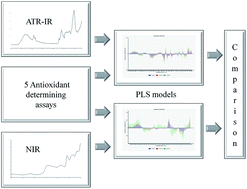Comparison of NIR and ATR-IR spectroscopy for the determination of the antioxidant capacity of Primulae flos cum calycibus†
Abstract
In this study, near-infrared (NIR) and attenuated-total-reflectance infrared (ATR-IR) spectroscopy techniques in hyphenation with partial least squares (PLS) regression were utilized to determine the antioxidant capacity of Primulae flos cum calycibus samples. Folin–Ciocalteu (FC), ferric ion reducing antioxidant power (FRAP), 2,2-diphenyl-picrylhydrazyl (DPPH), 2,2′-azino-bis-(3-ethylbenzothiazoline-6-sulfonic acid) diammonium salt (ABTS) and cupric reducing antioxidant capacity (CUPRAC) assays were performed as reference methods. Different spectral pretreatments such as standard normal variate (SNV), 1st or 2nd derivative, were applied to remove scattering effects. For all assays, cross and test-set validations were performed. The ability of the two spectroscopic techniques to replace the five assays was evaluated and compared. The standard error of prediction (SEP) and the ratio performance deviation (RPD) were determined and corrected for the imprecision of the reference data to obtain the respective SEPcorr and RPDcorr values. In general, NIR demonstrated advantages over ATR-IR spectroscopy and resulted best for the ABTS assay (R2: 0.94, RPDcorr: 4.66; test-set validation). Also with ATR-IR spectroscopy, the best prediction power was obtained for the ABTS assay (R2: 0.94, RPDcorr: 4.10; test-set validation). The feasibility of vibrational spectroscopy as a fast and simple tool to replace wet chemistry assays for the measurement of the antioxidant capacity of Primulae flos cum calycibus samples was demonstrated.


 Please wait while we load your content...
Please wait while we load your content...